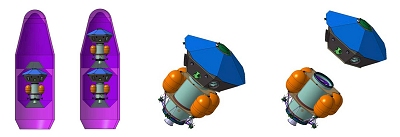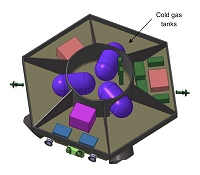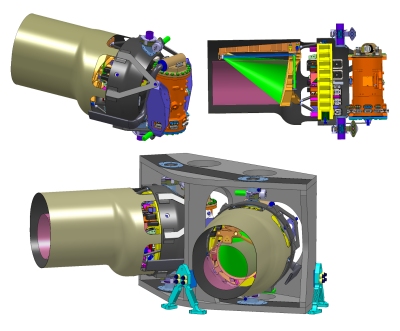Spacecraft and Payload
There will be six elements making up the New Gravitational wave Observatory (NGO) space segment: one 'Mother' spacecraft, two 'Daughter' spacecraft and three propulsion modules, one for each spacecraft, resulting in three launch composites.
 |
|
Mother/Daughter launch configuration in the Soyuz fairing (left) and spacecraft/propulsion module assembly (centre) and separated (right). Credit: EADS Astrium |
The spacecraft carry the science payload; in fact, the NGO mission is unusual in that the spacecraft and the payload together (often referred to as the sciencecraft) form the experiment. This interdependence is reflected in the design of both elements. The spacecraft is designed to take account of the gravitational requirements of the free-falling test masses, and the payload effectively controls the position of the spacecraft during science operations.
 |
|
View of the platform deck of the 'Mother' spacecraft. |
Each NGO spacecraft carries an identical payload (the Mother spacecraft carries two, the Daughters one each), provides resources for the payload, and accommodates the micropropulsion system. Three systems are currently under consideration: FEEPs, cold gas or mini-radiofrequency ion thrusters; any one of these can be accommodated in the NGO design. The three spacecraft buses are identical and re-use, to the maximum extent possible, the design that has been developed for LISA Pathfinder.
The propulsion modules, which are responsible for delivering the spacecraft to their operational orbits, will be separated following final orbit acquisition to ensure that no disturbance generated by them will affect the payload.
Payload
The NGO payload is a gravitational wave detector based on undisturbed, free-falling test masses and laser interferometry. The core components of the payload are the test masses, whose movement in response to gravitational waves – measured by the interferometric system - enable the detection of these waves.
The test masses are included within the Gravitational Reference Sensor (GRS, see below), which provides, amongst other things, the required shielding against external disturbances, such as solar radiation pressure and (to a certain degree) the interplanetary magnetic field, therefore limiting the residual acceleration that produces a displacement of the test masses from their central position. In addition, the spacecraft architecture has to ensure that the forces on the test mass are as small as possible, requiring special design precautions regarding the mass distribution, the thermal balance and the magnetic cleanliness. The GRS is able to sense this displacement of the test masses and to re-centre them by means of a control law and a micropropulsion system, thus implementing the so-called drag-free attitude control system (DFACS).
The GRS is solidly connected to the Optical Bench and to the Telescope, forming what is often called the Moving Optical Sub-Assembly or MOSA. The Mother spacecraft contains two MOSAs with a supporting structure and lasers and phasemeter, whilst the Daughter spacecraft contain only one MOSA each - fixed onto the spacecraft bus by means of six struts - plus lasers and phasemeter.
 |
|
Moving Optical Sub-Assembly. Credit: ESA |
The NGO payload is composed of elements that are either inherited from LISA Pathfinder or are the object of ongoing dedicated technology development activities performed by European industries and laboratories.
The scientific measurement is implemented by measuring the variation in distance between two test masses, 106 km apart, by means of an interferometric measurement system implemented with lasers and a phasemeter. The technique is described in the 'Measurement Concept' page.
Gravitational reference sensor (GRS)
The GRS contains a test mass, enclosed in a housing with electrodes that provide a capacitive readout of its position. The electrodes are arranged in such a way that all relevant degrees of freedom can be measured. Additional electrodes allow the test mass to be actuated in all but the sensitive measurement axis, in order to re-centre it – with the exception of the sensitive axis where the gravitational wave measurement actually takes place - following a displacement caused by residual noise.
The test masses are cubes made of an alloy of about 73% gold and 27% platinum; they have a mass of 1.96 kg and dimensions of 46 mm × 46 mm × 46 mm. The mixing ratio of the two metals is chosen such that the magnetic susceptibility can be made very small.
Relatively large gaps of around three millimetres between the test mass and its housing make it necessary that the test mass is held during launch by a caging mechanism, to avoid damage to the test mass surface coating or to the electrode housing due to the vibrations during launch.
The caging mechanism comprises a launch lock mechanism that must withstand the large loads imposed by the launch vehicle, and a Grabbing, Positioning and Release Mechanism (GPRM) to correctly position the test mass before free flying commences.
Disturbance reduction system (DRS)
The main objective of the DRS is to maintain the free fall of the test mass that serves as nominal reference point for the measurement of the inter-spacecraft distance. To do so, the DRS controls a drag-free attitude control system (DFACS) by measuring the position and orientation of the test mass with respect to the spacecraft, applying a control law and commanding micro-newton thrusters such that the test mass remains in its nominal position with respect to the spacecraft.
The sensitive axis of the DRS denotes the axis aligned with the line of sight to the telescope and consequently to the test mass in the distant spacecraft. As the Mother spacecraft employs two test masses, it is impossible to keep both of them in free fall in all degrees of freedom and ensure at the same time that the test masses stay close to their nominal position. However, it is sufficient to maintain free fall in the direction of the sensitive axes, which can be achieved by controlling the 'non-sensitive' degrees of freedom of the test masses and the position and attitude of the spacecraft. While the Daughter spacecraft houses only one test mass, in both cases small forces have to be applied as well to keep the test mass aligned with the line of sight of the telescope. These forces are only applied along the non-sensitive axes.
Interferometric measurement system
The optical system of NGO contains all the optical components that are needed for the interferometry and the required supporting measurements.
The main function of the optical bench is to direct the incoming laser beam to the photodiodes, allowing the measurement of the signal and to generate the outgoing signal by modulating a locally generated laser signal with the same phase as the received signal – that is, heterodyning it - for transmission to the distant spacecraft.
The laser that is required to generated the light beams uses a low-power stage that is largely identical to the laser used on LISA Pathfinder and a fibre power amplifier developed by European industry for telecommunication projects.
The telescope envisaged for NGO is an all-zerodur off-axis telescope with a 20-cm aperture, a mechanical length of about 60 cm and a field of view of about 7 micro-radians out-of-plane and about 4 micro-radians in plane.
The phasemeter on NGO must satisfy the requirements of a maximum admissible heterodyne frequency of 15 MHz and a frequency rate of change of up to 1 Hz/s; these requirements account for the relative motion of the spacecraft and the resulting Doppler effect. The phasemeter will perform the accurate measurement of the phase of the received signal, together with a very accurate time-stamping of the signal, based on a master time signal transferred between spacecraft on the laser sidebands. Ground processing using a sophisticated technique called Time Delayed Interferometry (TDI) will compare these signals and extract the gravitational wave signals.
Propulsion modules
The principal role of the propulsion modules is to provide the propulsive ΔV and attitude control following launcher separation, to transfer the spacecraft to an initial escape orbit, and then through a series of deep space manoeuvres to acquire their operational orbits, in response to commands from the attitude and orbit control system (AOCS) on the spacecraft and commands from ground.
For the NGO mission, maximum advantage will be taken of the development of a propulsion module for LISA Pathfinder, based on proven Eurostar communications satellite technology and specifically qualified for the needs of a science mission in which practically all propellant is used for main engine manoeuvres. The only change from the LISA Pathfinder design is the modification of the capacity of the propellant tanks.

